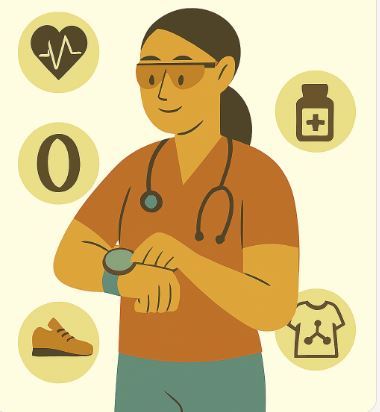When David’s smartwatch alerted him to an irregular heartbeat, he thought it was just a glitch. But after visiting his doctor, he discovered early signs of atrial fibrillation. That tiny device on his wrist may have saved his life.
This is the new reality: wearable technology is no longer just about fitness—it’s becoming a cornerstone of modern healthcare.
🧠 What Are Healthcare Wearables?
Healthcare wearables are devices designed to monitor, track, and sometimes even predict health conditions. They include:
- Smartwatches with ECG and blood oxygen sensors
- Fitness trackers with sleep and stress monitoring
- Smart rings for continuous health tracking
- Medical-grade wearables prescribed by doctors (e.g., glucose monitors, heart monitors)
🩺 Key Ways Wearables Are Transforming Healthcare
1. Early Detection of Health Issues
- Smartwatches can detect irregular heart rhythms, sleep apnea, or low oxygen levels.
- Continuous monitoring helps catch problems before they become emergencies.
2. Chronic Disease Management
- Diabetic patients use continuous glucose monitors (CGMs) to track blood sugar in real time.
- Wearables help manage hypertension, asthma, and cardiovascular conditions.
3. Remote Patient Monitoring
- Doctors can track patient vitals without in-person visits.
- Reduces hospital readmissions and improves care for elderly or rural patients.
4. Mental Health & Stress Tracking
- Devices measure heart rate variability (HRV) to detect stress.
- Guided breathing and mindfulness reminders support mental well-being.
5. Rehabilitation & Recovery
- Wearables track mobility and activity after surgery or injury.
- Data helps doctors personalize recovery plans.
6. Emergency Alerts & Safety
- Fall detection automatically contacts emergency services.
- GPS-enabled wearables help caregivers monitor vulnerable patients.
🔮 The Future of Healthcare Wearables
- AI Integration: Predictive analytics for early diagnosis.
- Smart Fabrics: Clothing that monitors hydration, posture, and muscle fatigue.
- Personalized Medicine: Data-driven insights tailored to each individual.
- Check out the top wearable tech devices that are leading this change.
📌 Action Plan
- If you’re managing a chronic condition, ask your doctor about medical-grade wearables.
- Use consumer wearables (smartwatches, rings) to track daily health habits.
- Pay attention to trends—AI-driven wearables will soon become standard in healthcare.
✅ Call to Action
Wearables are no longer just accessories—they’re healthcare partners.
👉 Start by using your device’s health features today, and see how small insights can lead to big improvements in your well-being.
❓ FAQ
Q: How are wearables used in healthcare?
A: They monitor vital signs, detect irregularities, manage chronic conditions, and support remote patient care.
Q: Can wearables really save lives?
A: Yes. Devices have detected heart issues, sleep disorders, and other conditions early, leading to timely medical intervention.
Q: What’s the future of healthcare wearables?
A: Expect AI-powered predictions, smart fabrics, and deeper integration with medical systems.
